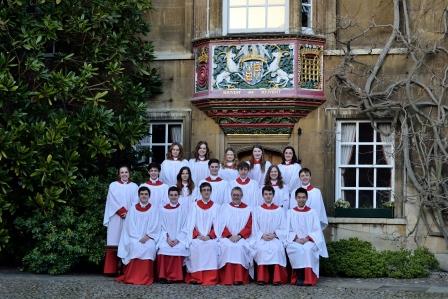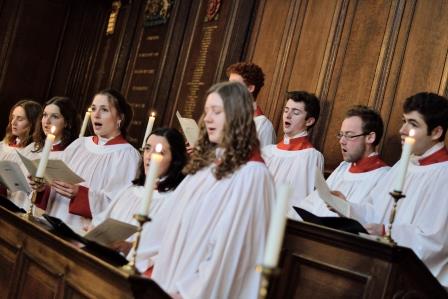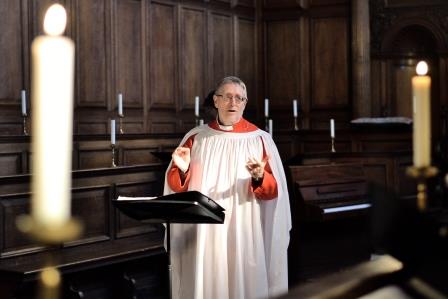
The Chaplain is the Revd Dr Helen Orchard, who arrived at the college at the beginning of Easter Term 2023.
Helen can be found in the Chaplain's Room on the ground floor of the Fellows' Building in Second Court (A1). She welcomes visits from any member of College, and will happily put the kettle on to have a conversation about any matter, be it pastoral, religious or random. You can contact her by email (chaplain@christs.cam.ac.uk)
Getting married in Christ's College Chapel
 The Chapel is a beautiful and sacred location for weddings. Since the building is a college chapel, rather than a parish church, any wedding requires a Special Licence from the Archbishop of Canterbury (rather than the reading of banns). This is fairly straightforward to obtain, so long as you have a close connection with the College. In other words, the bride and/or groom should be current students, fellows or staff, or alumni. For all marriage enquiries, please contact the Chaplain, and she can discuss your plans with you.
The Chapel is a beautiful and sacred location for weddings. Since the building is a college chapel, rather than a parish church, any wedding requires a Special Licence from the Archbishop of Canterbury (rather than the reading of banns). This is fairly straightforward to obtain, so long as you have a close connection with the College. In other words, the bride and/or groom should be current students, fellows or staff, or alumni. For all marriage enquiries, please contact the Chaplain, and she can discuss your plans with you.
It is not currently possible to hold weddings of same sex couples in the College Chapel; however, if you would like to organise a Service of Blessing following a Civil Marriage or Civil Partnership, please do contact the Chaplain, who will happily discuss options with you.
The College can also host wedding breakfasts and evening events. Please contact the Conference and Events Manager to discuss possible dates.

2025 Choir photo by Lafayette.
"fresh voices, precise pitching and chording, expert pacing"
BBC Music Magazine
NEWS FEBRUARY 2024: NEW CD RELEASE
Annabel McLauchlan Rooney Like to a flower released on Regent Records. Read about the recording.
| "the singing is first rate" Cross Rhythms Direct | "truly excellent performances" "beautifully accomplished" International Record Review |
| "utterly polished professionals: a triumph" San Francisco Classical Voice | "worthy of comparison with the best" Gramophone Magazine |
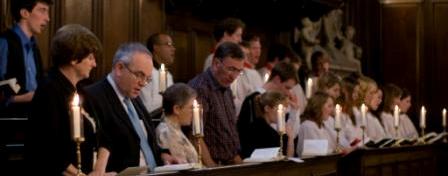
Chapel Life
The chapel or chaplaincy is much more than simply what goes on in college chapel – although the chapel is the focus for the many events or activities in the college community: music, arts as well as prayer, liturgy and worship.
The chapel is inclusive: that means that everyone is welcome. Every member of Christ’s is a member of the community and therefore has access to the chapel as a space to pray, or to rest or to reflect. The chapel and side chapel are open each day from 8am to after 10pm.
There is a regular and thriving chapel life – all leading up to and from the weekly Sunday services. There are social activities, faith discussion groups and an active musical circuit on many weekdays. There is always free refreshment after the principle chapel services, whether it be coffee and croissants, port, sherry, fruit juice, Prosecco or hot chocolate and a chance to meet and greet friends and newcomers.
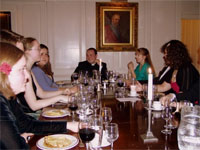 The chaplain works closely with chapel officers who are students. The chapel clerks, senior sacristans, and ushers all play a key role in making sure the chapel is a place of welcome and openness. Each term, the Sunday collections are donated to local, national and international charities which are decided at the termly chaplain’s advisory group meetings.
The chaplain works closely with chapel officers who are students. The chapel clerks, senior sacristans, and ushers all play a key role in making sure the chapel is a place of welcome and openness. Each term, the Sunday collections are donated to local, national and international charities which are decided at the termly chaplain’s advisory group meetings.
What if I have never been to a church or chapel before?
That's fine. There are no conditions or expectations on coming to College chapel. You will be made very welcome.
Can I get more involved?
Yes of course! Whether you are in Christ’s as a student, member of staff or fellow, or planning on coming to Christ’s, then you will have every chance of playing an active role in chapel, if you wish to. Many people simply come to worship or listen to the music and there will be no pressure on you to take ‘a job’. But, if you are willing to read, lead intercessions, serve at the Eucharist, act as an acolyte or administer the chalice or would like to be a chapel sacristan or usher, then all you have to do is talk to or contact the Chaplain!
If I am a third year and have never been to chapel before, can I still come along sometime?
Yes! The chapel is open and inclusive and a place of enquiry. If you have never been to chapel before but would like to come then all you have to do is walk through the door and a warm welcome awaits you! Even if you have been in Christ’s for 3 years and have never been inside the chapel.
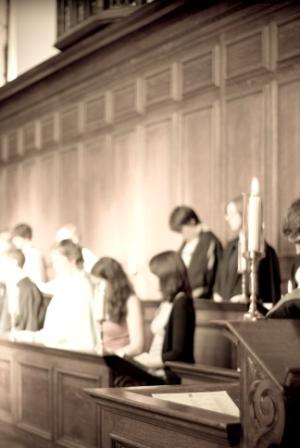 Can I come on my own?
Can I come on my own?
Yes. In fact many people come to chapel on their own to take time out, to gather strength, to find space, to pray and worship or simply to 'get away from it all'. Although it might be difficult to think of going somewhere on your own, without friends, a chapel service is different. It is not like going to the pub or the cinema: when in chapel, everyone is together and no-one will feel conspicuous. If you want to bring someone with you, all the better!
Is there a dress code?
No. Come as you are. God knows what you look like when you get up in the morning, so he can't be shocked.
Some people like to wear gowns becuase of tradition (it used to be compulsory), and some wear gowns because they are going to formal hall after the service, but there is absolutely no need to wear a gown in chapel. Services are not academic occasions, and therefore academic dress is not required.
top and bottom photographs taken by Samuel Palin
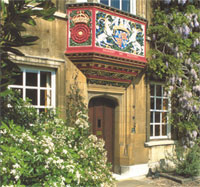 Christ's College was first established as God's House in 1437 by William Byngham, a London parish priest, for training grammar school masters. Shortly after receiving its Royal Licence from Henry VI in 1446, God's House was forced to move from its original site as this was needed for the King's new project (what was to become King's College). God's House moved to its present site in 1448 and in the same year received a second Royal Licence. This licence may be regarded as the Foundation Charter. Click here for a list of the Proctors of God's House.
Christ's College was first established as God's House in 1437 by William Byngham, a London parish priest, for training grammar school masters. Shortly after receiving its Royal Licence from Henry VI in 1446, God's House was forced to move from its original site as this was needed for the King's new project (what was to become King's College). God's House moved to its present site in 1448 and in the same year received a second Royal Licence. This licence may be regarded as the Foundation Charter. Click here for a list of the Proctors of God's House.
Following the death of her third husband, and the accession of her son as King Henry VII, the Lady Margaret Beaufort turned her energies to good causes. No doubt at the suggestion of her confessor, Bishop John Fisher, she decided to enlarge God's House. In 1505, with a royal charter from the King, the College was re-founded as Christ's College. Lady Margaret has been honoured ever since as the Foundress.
Surviving the twists and turns of the Reformation, Christ's became one of the leading Puritan colleges of Elizabethan Cambridge. In 1625 it admitted the young John Milton, who would become a leading Puritan apologist of the Civil War and one of the greats of 'English' literature. The Garden still boasts what is known as 'Milton's Mulberry Tree'.
The boom in student numbers in the seventeenth century required new accommodation, beyond the original College around what is now 'First Court'. The result was the beautiful 'Fellows' Building., built in the early 1640s after an appeal to Fellows and Old Members. This raised some five million pounds in today's money and we still have the list of donors.
Over the next century or so, Christ's was noted for several eminent scholars who sought to harmonise traditional Christian faith with the new truths of natural science. These included Cambridge Platonists such as Ralph Cudworth, and William Paley, whose Evidences of Christianity (1794) remained set reading in Cambridge until the twentieth century.
But Paley's synthesis of religion and science was soon to be overturned by another Christ's man - Charles Darwin, who came up in 1828, and lived in Paley's old rooms in First Court. On the Origin of Species was published some thirty years later, but the young Darwin's interest in botany and geology was nurtured at Cambridge.
Like the rest of Cambridge, life at Christ's was transformed by the Victorians, with more rigorous exams, the rise of experimental science and the opening of the University to non-Anglicans. The first half of the twentieth century was scarred by two world wars, whose effect is movingly commemorated on the plaque in the Chapel. The College of the 1930s is evoked (and caricatured) in the celebrated novel The Masters (1951) by the scientist and author, C.P. Snow.
After 1945 Christ's shared in the general boom in higher education, with new blocks to complete Third Court and then New Court designed by Sir Denys Lasdun. Among its intellectual dynamos were Lord Todd, the Nobel prize-winning chemist; James Meade, a Nobel laureate in economics; and Sir John Plumb, the celebrated historian.
This is only a taste of the College's past. Those with bigger appetites should consult the quincentenary history edited by David Reynolds, Christ's: A Cambridge College over Five Centuries (Macmillan, 2004) with contributions from distinguished Christ's historians such as Simon Schama, Roy Porter and David Cannadine.
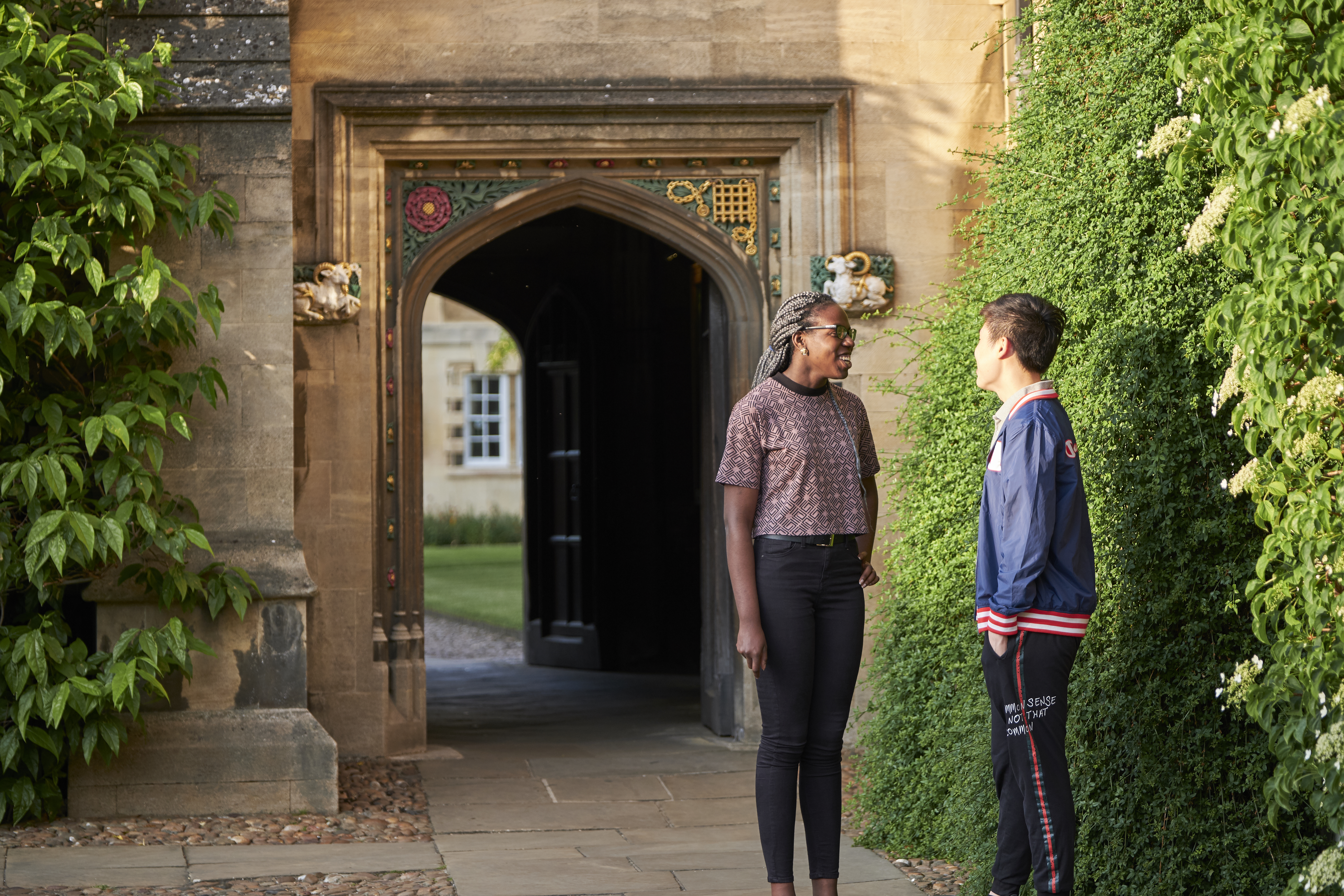 Christ's is distinctive amongst the Cambridge Colleges. It offers strong tutorial support to its students as they pursue their academic work. While excellence in scholarship is especially prized at Christ's, all members are encouraged to explore a wide range of outside interests, and innumerable extra-curricular activities flourish amongst the students: sport, music, drama and films, debating, and many, many more.
Christ's is distinctive amongst the Cambridge Colleges. It offers strong tutorial support to its students as they pursue their academic work. While excellence in scholarship is especially prized at Christ's, all members are encouraged to explore a wide range of outside interests, and innumerable extra-curricular activities flourish amongst the students: sport, music, drama and films, debating, and many, many more.
The College is small enough to be friendly and personal, yet large enough for all members to be able to find others with interests to match their own.
In this section of the website you can find all the general information you might need about the College.
Depending on your interest you may also want to visit the Admissions or Conferences sections of the site. If you are interested in learning more about the people at Christ's, or want to learn how to contact them then you may like to visit the People section.
If you are unable to find the information you are looking for you may find the Search facility useful. If you are still not able to find the information you want then you can contact the webmaster who will try and assist you.

